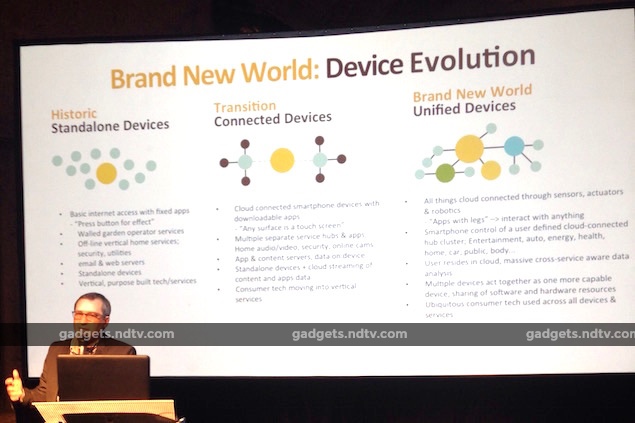- Home
- Internet
- Internet Features
- MediaTek Bets Big on the Internet of Things
MediaTek Bets Big on the Internet of Things

We know that a company has its head firmly planted on its shoulders when its President willingly accepts a need to get out of the comfort zone in order to concentrate on new areas where it hopes to develop expertise. We are talking about MediaTek and its latest direction - helping developers/ partners create sustainable and innovative Internet of Things (IoT) tech.
CJ Hseih, President, MediaTek believes that currently there are many players in the Internet of Things (IoT) space thus causing market fragmentation beyond repair. He believes that the Taiwanese company may have a solution for it by rethinking the whole turnkey strategy approach. Through new platforms like LinkIt and CrossMount, MediaTek plans to make it easier for partners, and eventually the end customers, to create IoT solutions that can simply work. Unlike its smartphone SoCs, LinkIT and CrossMount are solutions that includes a hardware development kit (HDK), software development kit (SDK) or both.
LinkIt One and LinkIt Connect
At Computex 2014, MediaTek Labs division announced LinkIt One, which includes the Aster MT2502 SoC. MediaTek claimed at the time the MT2502 is the smallest chip in the world that can power wearables and IoT devices. At the recently concluded Mobile World Congress (MWC) in Barcelona, MediaTek showed off its latest LinkIt Connect solution that includes the MediaTek MT7681 - a compact Wi-Fi-enabled System-on-Chip (SoC). Both these development platforms use the LinkIt SDK.
At the moment however, the use cases are very region-specific and two of the most interesting ones that Marc Nadell, VP of Ecosystems, MediaTek highlighted were both demonstrated at AT&T Developer Summit and Hackathon in Las Vegas, an event sponsored by MediaTek Labs.
In one demo, a bunch of developers made Red Alert - a drone that was made for corporate campuses where it aims to replace the "group leader with a clipboard" model used in fire drill or an actual emergency situation. This drone, fitted with a LinkIt One, is released at the rally point in case of an emergency. Employees escape from the building after launching an app on their smartphones or wearables and once they reach the rally point, the drone detects their presence and marks it. Once all the employees are out a blinking red light turns green thus indicating that the campus has been evacuated entirely.
Another project at the hackathon used a WebRTC-powered Web app to video call your pet when the you are not at home. PetAlone is a device that uses LinkIt One with a servomotor, a rotary actuator motor that allows for precise control of angular position, velocity and acceleration. It lets users give their pets a treat by pressing a button on the Web app from a remote location.
(Watch the entire hackathon here)
Both are innovative examples in their own right but it doesn't end there, since developers are coming up with more solutions for everyday problems. It looks like the time is ripe for MediaTek to enter the fray. One advantage that MediaTek has is that it prices the entire solution for an affordable price of $79 (approximately Rs. 5,000) - which includes the HDK and the SDK.
Nadell says, "One of the things that MediaTek consistently does is to create advantages for its partners by integrating to a high degree. This impacts how many components goes into the hardware setup of the wearable and also allows users to make devices in smaller sizes. Also, integration usually saves on power because you have fewer discreet elements and that impacts battery life in a good way. So with a smaller size unit, you are cutting down on the cost without cutting the performance and saving on the battery life."
CrossMount
If we have to zero down on one technology that MediaTek was excited most about at their MWC event in Barcelona, it has to be CrossMount. This technology based on popular Universal Plug and Play (UPnP) aims to be more than just a DLNA clone.
Kevin Jou, CTO, MediaTek explains, "CrossMount tries to do more than just exchanging data. We want to have multiple devices to work together. Together they can provide functionality like each of the single devices cannot."
At the event, Jou talked about an example where two smartphones in the same area with bad cellular reception can make use of the combined strength of the radios inside each other to boost the network. Another example that MediaTek highlighted, pictured a situation wherein the microphone inside a smartphone can be used as a voice controller to search content inside a smart TV. In a sense, different devices can use both - the hardware and software - inside each other to communicate with each other or the outside world.
Now, while these examples do sound interesting and pragmatic, there were no demos at the show floor in Barcelona, which likely means we are still a few steps away from this becoming a reality.
Having said that, Jou is pretty excited about CrossMount. He mentions how CrossMount is an open technology and that MediaTek is willing to work with anyone. CrossMount Alliance aims to bring all of MediaTek's partners and interested developers under one umbrella to figure out how to move this technology forward. MediaTek states that Chang-hong, Hisense, Lenovo and TCL are already on board and have extended support for CrossMount.
CrossMount is expected to be available in Q3 this year for Android devices and finished retail products should hit the shelves before the year ends. For CrossMount to gain mass-market approval, it is essential that most of MediaTek's existing customers/ partners come together to create workable solutions and try to avoid gimmicks.
The IoT Paradigm
While Mediatek's ambitions are commendable, it has a really tough battle ahead of itself. Giants like Qualcomm and Intel have their very own IoT solutions and strategies, as does anyone else under the sun. In fact, Intel's IoT business has already turned profits, which is huge considering IoT is still thought of by many has nothing but a buzzword. Similarly, Qualcomm has a huge stake in IoT by the virtue of that it is a behemoth in the mobile chipset space. Qualcomm started the AllSeen alliance with the idea of making all the protocols it made in association with AllJoyn open and this alliance already has over 140 members.
The pace at which IoT has progressed is unlike a lot of other forward-looking futuristic technology we've seen before. It is refreshing to see growing partnerships and enthusiastic developers in this space. MediaTek's simplistic IoT strategy helps the company distinguish itself from the clutter a bit but we'll have to wait and watch how this strategy pans out for the company. In any case, connected homes, smart cities and intelligent automobiles are much closer to reality than you think.
Disclosure: The correspondent's hotel and flights for Barcelona were sponsored by MediaTek.
Get your daily dose of tech news, reviews, and insights, in under 80 characters on Gadgets 360 Turbo. Connect with fellow tech lovers on our Forum. Follow us on X, Facebook, WhatsApp, Threads and Google News for instant updates. Catch all the action on our YouTube channel.
- Samsung Galaxy Unpacked 2025
- ChatGPT
- Redmi Note 14 Pro+
- iPhone 16
- Apple Vision Pro
- Oneplus 12
- OnePlus Nord CE 3 Lite 5G
- iPhone 13
- Xiaomi 14 Pro
- Oppo Find N3
- Tecno Spark Go (2023)
- Realme V30
- Best Phones Under 25000
- Samsung Galaxy S24 Series
- Cryptocurrency
- iQoo 12
- Samsung Galaxy S24 Ultra
- Giottus
- Samsung Galaxy Z Flip 5
- Apple 'Scary Fast'
- Housefull 5
- GoPro Hero 12 Black Review
- Invincible Season 2
- JioGlass
- HD Ready TV
- Laptop Under 50000
- Smartwatch Under 10000
- Latest Mobile Phones
- Compare Phones
- OnePlus 15R
- Realme Narzo 90x 5G
- Realme Narzo 90 5G
- Vivo S50 Pro Mini
- Vivo S50
- OPPO Reno 15c
- Redmi Note 15 5G
- Redmi Note 15 Pro 5G
- Asus ProArt P16
- MacBook Pro 14-inch (M5, 2025)
- Infinix Xpad Edge
- OnePlus Pad Go 2
- OnePlus Watch Lite
- Just Corseca Skywatch Pro
- Acerpure Nitro Z Series 100-inch QLED TV
- Samsung 43 Inch LED Ultra HD (4K) Smart TV (UA43UE81AFULXL)
- Asus ROG Ally
- Nintendo Switch Lite
- Haier 1.6 Ton 5 Star Inverter Split AC (HSU19G-MZAID5BN-INV)
- Haier 1.6 Ton 5 Star Inverter Split AC (HSU19G-MZAIM5BN-INV)












